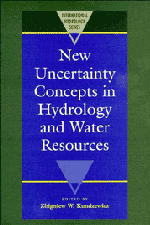Book contents
- Frontmatter
- Contents
- List of Authors
- Preface
- I INTRODUCTION
- II FACETS OF UNCERTAINTY
- III NOVEL APPROACHES TO UNCERTAINTY: FRACTALS, FUZZY SETS AND PATTERN RECOGNITION, NON-PARAMETRIC METHODS
- 1 Dispersion in stratified soils with fractal permeability distribution
- 2 Multifractals and rain
- 3 Is rain fractal?
- 4 Multifractal structure of rainfall occurrence in West Africa
- 5 Analysis of high-resolution rainfall data
- 6 Application of fuzzy theory to snowmelt runoff
- 7 On the value of fuzzy concepts in hydrology and water resources management
- 8 Application of neural network in groundwater remediation under conditions of uncertainty
- 9 Application of pattern recognition to rainfall–runoff analysis
- 10 Nonparametric estimation of multivariate density and nonparametric regression
- 11 Nonparametric approach to design flood estimation with pre-gauging data and information
- IV RANDOM FIELDS
- V TIME SERIES AND STOCHASTIC PROCESSES
- VI RISK, RELIABILITY AND RELATED CRITERIA
6 - Application of fuzzy theory to snowmelt runoff
Published online by Cambridge University Press: 07 May 2010
- Frontmatter
- Contents
- List of Authors
- Preface
- I INTRODUCTION
- II FACETS OF UNCERTAINTY
- III NOVEL APPROACHES TO UNCERTAINTY: FRACTALS, FUZZY SETS AND PATTERN RECOGNITION, NON-PARAMETRIC METHODS
- 1 Dispersion in stratified soils with fractal permeability distribution
- 2 Multifractals and rain
- 3 Is rain fractal?
- 4 Multifractal structure of rainfall occurrence in West Africa
- 5 Analysis of high-resolution rainfall data
- 6 Application of fuzzy theory to snowmelt runoff
- 7 On the value of fuzzy concepts in hydrology and water resources management
- 8 Application of neural network in groundwater remediation under conditions of uncertainty
- 9 Application of pattern recognition to rainfall–runoff analysis
- 10 Nonparametric estimation of multivariate density and nonparametric regression
- 11 Nonparametric approach to design flood estimation with pre-gauging data and information
- IV RANDOM FIELDS
- V TIME SERIES AND STOCHASTIC PROCESSES
- VI RISK, RELIABILITY AND RELATED CRITERIA
Summary
ABSTRACT Fuzzy theory (logic) is introduced to reduce uncertainty in the prediction of snowmelt runoff. It has been used to control plants, traffic junctions, subway systems, etc. The tanks model of Sugawara seems to be the most reliable method enabling computation of the snowmelt runoff in Japanese conditions. However, it is difficult to identify the parameters of this model and much data are needed for calibration. Fuzzy logic is the tool that gives the best prediction while it does not require the optimal parameters of the prediction model (tanks model). If the fuzzy logic is employed, the deviation between the observed values and the predicted ones is automatically minimized step by step. The prediction by the fuzzy logic is based on the value of the membership functions used. The effect of different membership functions on the prediction is tested by changing coefficients in time. As a result, despite the complexity of the phenomenon of snowmelt runoff, the prediction is in a good agreement with observation.
INTRODUCTION
A fuzzy set theory developed by Zadeh (1965) is presently being applied in many fields. For example, Mamdani (1974, 1981) used a fuzzy algorithm to control a plant (laboratorybuilt steam engine). Further, Pappis & Mamdani (1977) used the fuzzy logic for a traffic-junction control. Recent use of fuzzy methods can be found in the field of complex industrial processes (Tong, 1977) and feedback analysis (Cumani, 1982, Tanaka et al., 1982, and Tong, 1980). Fujita (1985) predicted runoff from rainfall by adopting a fuzzy logic.
- Type
- Chapter
- Information
- New Uncertainty Concepts in Hydrology and Water Resources , pp. 121 - 125Publisher: Cambridge University PressPrint publication year: 1995



